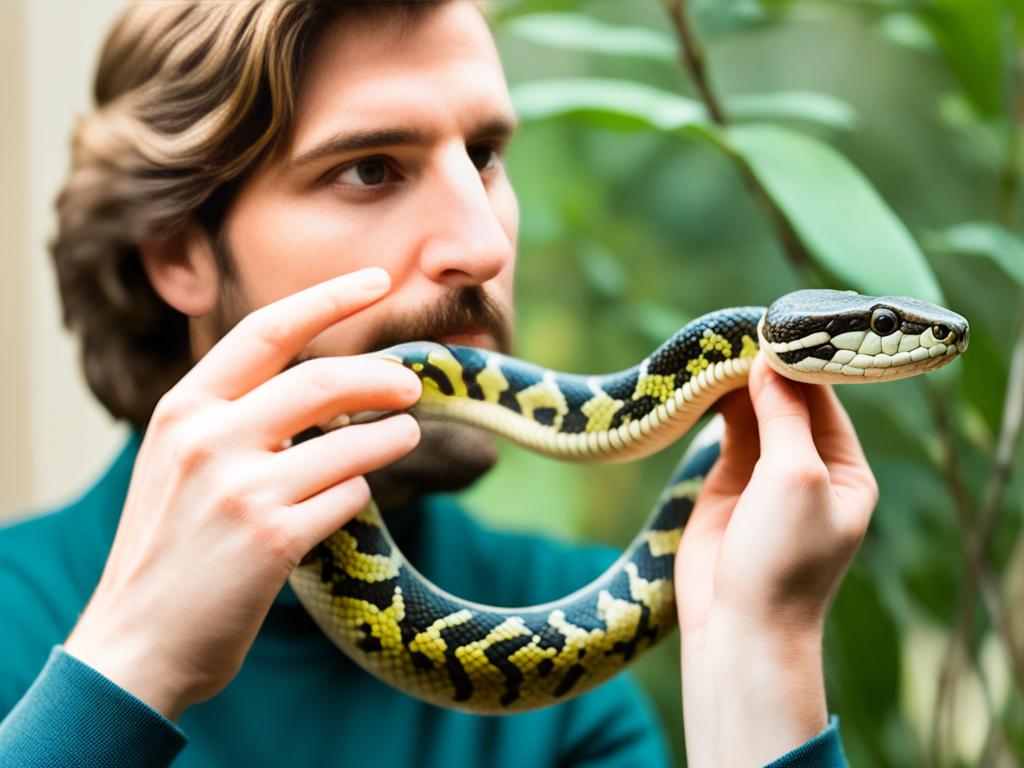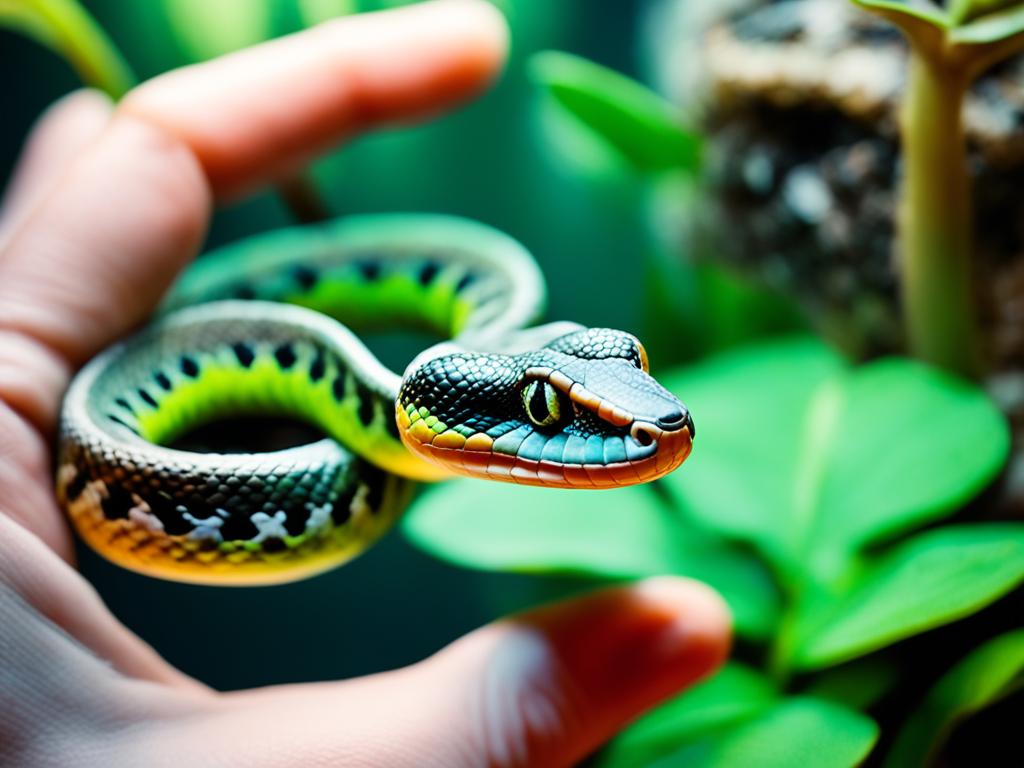Imagine the feeling of pure fascination and wonder as you watch a slender, elegant snake gliding gracefully through its habitat. The way its scales shimmer under the warm light, reflecting a rainbow of colors, brings a smile to your face. As a beginner in the world of pet snakes, you may be filled with curiosity and excitement about this unique and captivating reptilian companion.
But where do you start? How do you provide the best care for your scaly friend? Don’t worry, because this beginner’s guide to pet snakes, aptly titled Scales and Smiles, is here to help you embark on this incredible journey. Whether you’re enthralled by the magnificent patterns of a ball python or are charmed by the gentle disposition of a corn snake, this guide will equip you with the knowledge and confidence to become a responsible snake parent.
Throughout this guide, you’ll discover everything you need to know about choosing the right snake, creating the perfect habitat, handling and care, and building a deep bond with your scaly companion. So let’s dive in and uncover the secrets behind keeping pet snakes!
Key Takeaways:
- Choosing the right snake involves considering factors like species temperament and care requirements.
- Creating a suitable habitat for your pet snake is crucial for its overall well-being.
- Proper snake handling techniques and regular health checks are essential for their care.
- Building a bond with your snake involves interaction, socialization, and understanding their behavior.
- Responsible pet ownership ensures a happy and healthy life for your snake.
Choosing the Right Snake for You
When it comes to pet snakes, finding the perfect match for your lifestyle and preferences is key. With so many different species to choose from, it’s important to consider several factors before making your decision. This section will guide you through the process of selecting a pet snake, providing you with essential information to make an informed choice.
Firstly, it’s crucial to consider the level of experience needed to care for certain snake species. As a beginner, it’s advisable to opt for a snake with low maintenance requirements, such as a corn snake or a ball python. These snakes are known for their docile nature and relatively simple care needs, making them ideal for first-time owners.
Secondly, you’ll want to take into account the temperament and size of the snake. Some species may be more prone to aggression or require more handling experience. For example, while a king snake can make a fascinating pet, they tend to be more nervous and defensive, requiring a confident owner who can confidently handle them. Conversely, a gentle and friendly species like the rosy boa might be more suitable for someone seeking a laid-back and manageable companion.
Furthermore, it’s essential to research the specific care requirements of each snake species before bringing one home. Factors such as temperature, humidity, and diet should align with your ability to provide the necessary conditions. Selecting a snake that matches your lifestyle and commitment level will contribute to a successful and fulfilling ownership experience.
Here are some popular snake species that are often recommended for beginners:
- Corn Snake – These colorful snakes are relatively easy to care for and have a friendly temperament.
- Ball Python – Known for their docile nature, ball pythons make excellent pets for beginners.
- Rosy Boa – With their small size and calm demeanor, rosy boas are a popular choice for first-time snake owners.
Remember, owning a pet snake is a long-term commitment, with some species living well over 20 years. Take the time to research different snake species, consult with experienced snake owners, and interact with snakes at reptile expos or local pet stores before making your final decision. By considering all these factors, you’ll be well on your way to finding the perfect snake companion that suits your lifestyle and brings you years of enjoyment.
Creating the Perfect Reptile Habitat
Creating a suitable habitat is crucial for the well-being of your pet snakes. A properly designed environment not only ensures their physical health but also helps them feel secure and content in their surroundings. Here are some essential elements to consider when setting up a snake habitat:
Temperature Control
Snakes are ectothermic creatures, meaning they rely on external sources of heat to regulate their body temperature. It is vital to provide a temperature gradient within the habitat to allow your snakes to move between warmer and cooler areas as needed. This can be achieved by incorporating a heating pad or lamp at one end of the enclosure, while leaving the other end cooler. This temperature variation will enable your snakes to thermoregulate and maintain optimal health.
Humidity Levels
Depending on the species of snake, maintaining the appropriate humidity level is essential for their overall health and shedding process. Research the specific requirements of your snake to determine the ideal humidity range. You can use terrarium misters, humidifiers, or specific substrates to regulate the moisture levels. Regular monitoring and adjustments will help create a comfortable and healthy environment.
Lighting
While many snakes don’t require UV lighting, providing a light source that mimics natural daylight can still benefit their overall well-being. Light cycles that simulate day and night can help regulate their internal biological processes, such as digestion and activity levels. Ensure that the lighting is not too bright or harsh, as snakes also need a dark and quiet space to retreat and feel secure.
Substrate Selection
Choosing the right substrate is crucial for creating a clean and comfortable habitat for your snakes. The substrate should mimic their natural environment and be easily maintainable. Options such as aspen shavings, cypress mulch, reptile carpet, or paper towels can be suitable choices. Avoid substrates that may cause impaction or respiratory issues in your snakes.
By carefully considering and implementing these essential elements within the snake habitat, you can provide an environment that closely resembles their natural habitat. This will contribute to their overall well-being, making your snakes happier and healthier pets.
Incorporating these snake care tips into your reptile habitat will help you create an optimal living space for your pet snakes. Remember to research the specific needs of your snake species to ensure you meet their individual requirements. A well-designed habitat will not only promote their physical health but also enable them to thrive and exhibit natural behaviors.
Snake Handling and Care
Proper handling and care are vital for maintaining the well-being of pet snakes. Whether you’re a beginner or an experienced snake owner, understanding the right techniques is essential to ensure both your safety and the snake’s comfort. Here are some snake handling tips and care guidelines to help you provide the best possible environment for your scaly companion.
Safe Snake Handling Techniques
When it comes to handling pet snakes, it’s crucial to prioritize safety for both yourself and the snake. Follow these snake handling tips to minimize stress and avoid any potential harm:
- Approach the snake calmly and slowly, using gentle movements to avoid startling it.
- Support the snake’s body properly, especially when lifting or holding it. This helps prevent injuries, discomfort, or unnecessary stress.
- Avoid sudden movements or loud noises that may startle the snake.
- Always wash your hands before and after handling a snake to maintain hygiene and prevent cross-contamination.
Avoid handling snakes when they are shedding or during feeding time, as this can make them more defensive or aggressive. Remember, each snake has its own temperament, so it’s important to observe and respect their behavior.
Understanding Snake Behavior
Snakes are fascinating creatures with unique behavior patterns. Understanding their behavior can help you provide appropriate care and avoid unnecessary stress. Here are some key aspects to consider:
- Snakes are solitary animals that require their own space and territory.
- They are ectothermic, meaning they rely on external sources of heat to regulate their body temperature.
- Snakes rely on their sense of smell and heat detection to navigate their surroundings and locate prey.
- Some snake species are more docile and tolerate handling better than others. Do thorough research on the specific species you own to understand their temperament.
Feeding Routines and Health Checks
Proper feeding is crucial for maintaining the health of pet snakes. Follow these snake care tips for feeding:
- Provide a diet appropriate for the snake’s species. Most snakes eat a diet of rodents, either live or pre-killed.
- Offer appropriately sized prey items that are proportional to the snake’s size and age. Feeding too large or too small prey can lead to digestive problems.
- Establish a regular feeding schedule, usually every 1-2 weeks, depending on the snake’s age and species.
- Monitor the snake’s feeding behavior and overall appetite to ensure it’s consuming an adequate diet.
In addition to feeding routines, regular health checks are essential to detect any potential health issues. Consult with a reptile veterinarian for guidance on snake health exams and appropriate vaccinations.
“Proper handling techniques and care practices are essential for the well-being of pet snakes, ensuring their safety and yours. Remember to prioritize their comfort, observe their behavior, and follow recommended feeding routines and health checks.”

| Snakes | Handling Tips | Care Guidelines |
|---|---|---|
| Ball Python | Handle gently and support their body. | Provide a warm and humid habitat. |
| Corn Snake | Maintain a calm environment during handling. | Offer a balanced diet and provide hiding spots. |
| King Snake | Avoid handling during feeding time. | Ensure a secure enclosure with appropriate substrate. |
In summary, proper snake handling techniques and care practices are crucial to foster a healthy and thriving pet snake. By understanding and respecting your snake’s behavior, following safe handling methods, and providing appropriate feeding routines and health checks, you can ensure a rewarding and fulfilling experience as a snake owner.
For further information and fascinating facts about snakes, check out this resource on snake myths and facts.
Bonding with Your Snake
Building a strong bond with your pet snake is a rewarding part of snake ownership. Interacting with them not only helps foster trust but also allows you to appreciate their unique behaviors. Contrary to common misconceptions, snakes can be affectionate companions for reptile enthusiasts. Knowing the right way to interact, socialize, and communicate with your snake is essential for a harmonious relationship.
One effective way to bond with your snake is to handle them regularly. Start with short handling sessions and gradually increase the duration as your snake becomes more comfortable. Remember to handle them gently but firmly, supporting their body to make them feel secure. By handling your snake regularly, you’ll help them become accustomed to being touched and held, which can build trust over time. Be sure to follow proper snake handling tips to ensure the safety of both you and your pet.
Spending quality time with your snake outside of their enclosure can also strengthen your bond. Allow them to explore a safe and supervised environment, such as a snake-proof room or an outdoor enclosure. This will provide them with mental stimulation and an opportunity to exercise. Just be cautious and ensure there are no potential hazards or escape routes nearby.
Remember, each snake has its own unique personality. Some may be more curious and adventurous, while others may be more reserved. Respect their individuality and adjust your interaction style accordingly.
Creating a positive environment during interaction is crucial. Snakes are sensitive to vibrations and scents, so avoid sudden movements or loud noises that may startle them. Talk to your snake in a calm and soothing tone, allowing them to become familiar with your voice. This can help establish trust and make them feel more secure in your presence.
Another way to bond with your snake is through regular feeding. Snakes associate food with positive experiences, so feeding them can create a positive association and reinforce your bond. Be consistent with feeding routines and ensure that you offer appropriate prey items that match your snake’s size and species. Always follow proper snake care guidelines when feeding to prevent any potential health issues.
Remember, building a bond with your snake takes time and patience. Consistency, respect, and understanding are key components of a strong relationship. By following these snake handling tips and engaging in regular interaction, you’ll cultivate a bond that will enrich both your life and the life of your scaly friend.

For more insights into snake behavior and the bond between humans and these fascinating reptiles, check out this article from National Geographic on snake charmers and their impact on cobra wellness: https://news.nationalgeographic.com/2018/04/snake-charmers-tour-india-cobra-wellness/.
Conclusion
In conclusion, owning pet snakes can be a rewarding and fulfilling experience. Throughout this beginner’s guide, we have explored various aspects of snake ownership, from choosing the right snake for you to creating the perfect reptile habitat. We have also discussed the importance of proper snake handling and care, as well as building a strong bond with your scaly companion.
By following the tips and guidelines provided in this guide, you can ensure that your pet snake, whether it’s a corn snake or a ball python, thrives in its environment. Remember, responsible pet ownership is crucial for the well-being of your snake. Regular health checks, proper feeding routines, and understanding their behavior are all essential in keeping your pet snake happy and healthy.
If you still have questions or want to delve deeper into the world of pet snakes, there are valuable resources available online. To debunk common snake myths and learn more about these fascinating reptiles, visit Reptiles Magazine. Additionally, if you’re interested in exploring other reptile pets like turtles and tortoises, Reptile Pets Rock offers valuable information for beginners.
So, whether you are a reptile enthusiast or just starting your journey into snake ownership, remember that with proper care and knowledge, your pet snake can bring you many years of joy and fascination. Embrace the adventure, provide a loving home, and enjoy the scales and smiles that come with keeping pet snakes.




